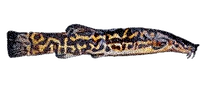 Summary of lasiancistrus Summary of lasiancistrus |
|---|
| Pronounced | LASS ee an SISS truss |
| Etymology | Greek, lasios, -a, -on = hairy + Greek, agkistron = hook |
| Identification | Adult Lasiancistrus can be separated from all other loricariids by the presence of whisker-like odontodes on the cheeks. In addition, they have evertible cheek odontodes; three rows of plates on the caudal peduncle; and a modified, bar-shaped opercle. The caudal fin is slightly emarginate to forked, with the lower lobe longer than upper. Nuptial males have tentacules on the pectoral-fin spines longer than their associated odontodes; and transluscent tentacules on the snout that have odontodes associated with them. Nuptial males lack hypertrophied odontodes on top of the head and lack long, bristle-like odontodes on the leading edge of the pectoral-fin spine. |
| Sexing | Snout of nuptial males almost square (vs. rounded in females and juveniles). Adult males of most species (except Lasiancistrus tentaculatus) with whisker-like odontodes at anterolateral corner of snout; males of L. tentaculatus have tentacules instead of whisker-like odontodes along anterior margin of snout. Nuptial males have tentacules longer than their associated odontodes on the pectoral-fin spine. |
| Size | Smallest 75mm, largest 198mm, average 135mm, most commonly 150mm. All SL. |
| Species | There are 25 "species" in the database |
| Keepers | 9 species (36%) are being kept by registered keepers |
| New spp. / time |  |  |  |  |  |  |  |  |  |  |  |  |  |  | | 1750 | 1770 | 1790 | 1810 | 1830 | 1850 | 1870 | 1890 | 1910 | 1930 | 1950 | 1970 | 1990 | 2010 |
|
| Distribution |
Login to view the map. |





/siluriformes/loricariidae/lasiancistrus/tentaculatus/1.jpg)
/siluriformes/loricariidae/lasiancistrus/heteracanthus/1.jpg)
/siluriformes/loricariidae/lasiancistrus/sp%28l178%29/1.jpg)
/siluriformes/loricariidae/lasiancistrus/sp%28l033%29/1.jpg)
/siluriformes/loricariidae/lasiancistrus/sp%281%29/1.jpg)
/siluriformes/loricariidae/lasiancistrus/sp%28l479%29/1.jpg)
/siluriformes/loricariidae/lasiancistrus/sp%28l228%29/1.jpg)
/siluriformes/loricariidae/lasiancistrus/saetiger/1.jpg)
/siluriformes/loricariidae/lasiancistrus/volcanensis/1.jpg)
/siluriformes/loricariidae/lasiancistrus/caucanus/1.jpg)
/siluriformes/loricariidae/lasiancistrus/guacharote/1.jpg)
/siluriformes/loricariidae/lasiancistrus/heteracanthus/1.jpg)
/siluriformes/loricariidae/lasiancistrus/planiceps/1.jpg)
/siluriformes/loricariidae/lasiancistrus/saetiger/1.jpg)
/siluriformes/loricariidae/lasiancistrus/schomburgkii/1.jpg)
/siluriformes/loricariidae/lasiancistrus/scolymus/1.jpg)
/siluriformes/loricariidae/lasiancistrus/sp%60itaituba%60/1.jpg)
/siluriformes/loricariidae/lasiancistrus/sp%281%29/1.jpg)
/siluriformes/loricariidae/lasiancistrus/sp%28l033%29/1.jpg)
/siluriformes/loricariidae/lasiancistrus/sp%28l178%29/1.jpg)
/siluriformes/loricariidae/lasiancistrus/sp%28l228%29/1.jpg)
/siluriformes/loricariidae/lasiancistrus/sp%28l337%29/1.jpg)
/siluriformes/loricariidae/lasiancistrus/sp%28l365%29/1.jpg)
/siluriformes/loricariidae/lasiancistrus/sp%28l479%29/1.jpg)
/siluriformes/loricariidae/lasiancistrus/sp%28l516%29/1.jpg)
/siluriformes/loricariidae/lasiancistrus/tentaculatus/1.jpg)
/siluriformes/loricariidae/lasiancistrus/volcanensis/1.jpg)